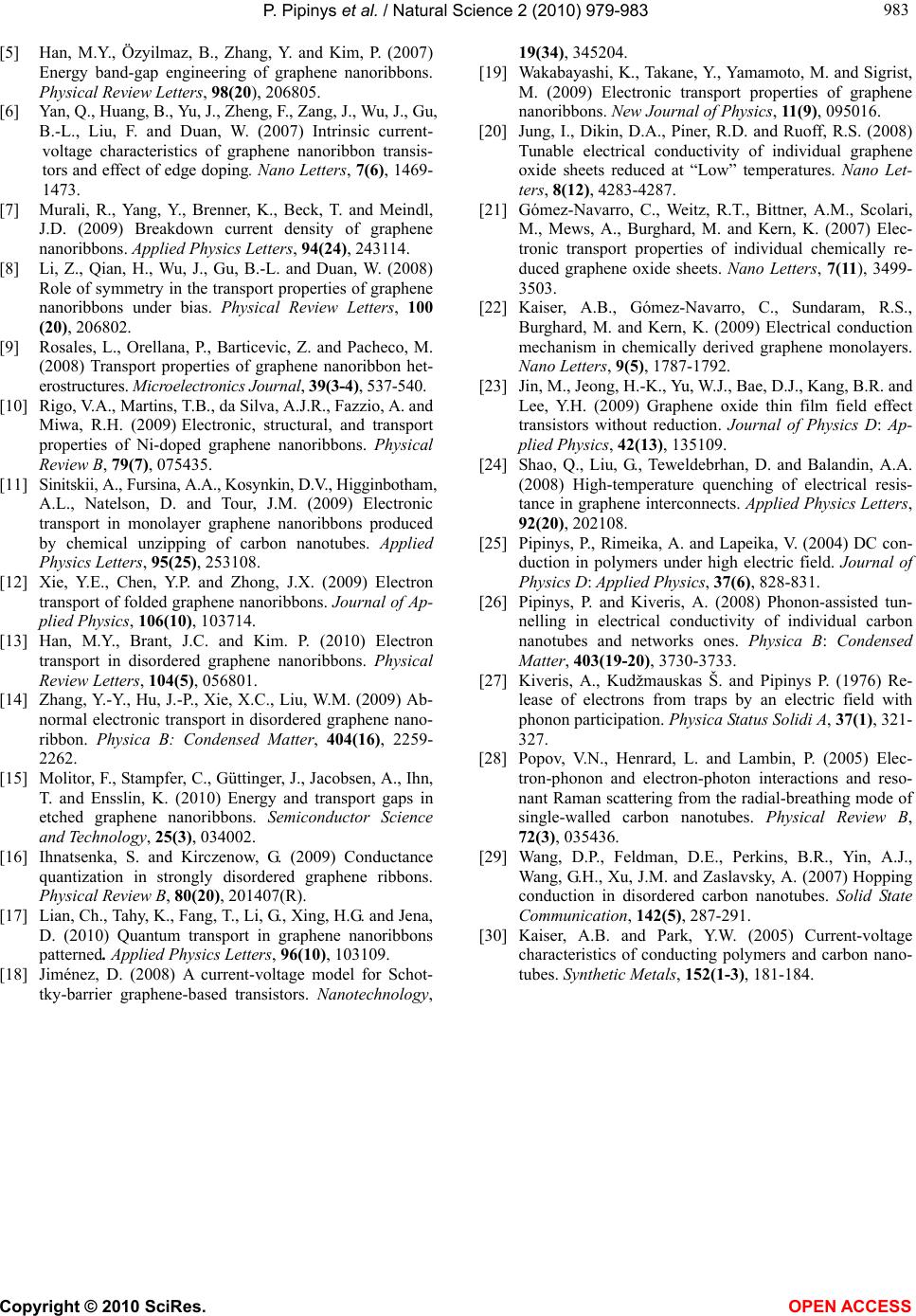
P. Pipinys et al. / Natural Science 2 (2010) 979-983
Copyright © 2010 SciRes. OPEN ACCESS
983
983
[5] Han, M.Y., Özyilmaz, B., Zhang, Y. and Kim, P. (2007)
Energy band-gap engineering of graphene nanoribbons.
Physical Review Letters, 98(20), 206805.
[6] Yan, Q., Huang, B., Yu, J., Zheng, F., Zang, J., Wu, J., Gu,
B.-L., Liu, F. and Duan, W. (2007) Intrinsic current-
voltage characteristics of graphene nanoribbon transis-
tors and effect of edge doping. Nano Letters, 7(6), 1469-
1473.
[7] Murali, R., Yang, Y., Brenner, K., Beck, T. and Meindl,
J.D. (2009) Breakdown current density of graphene
nanoribbons. Applied Physics Letters, 94(24), 243114.
[8] Li, Z., Qian, H., Wu, J., Gu, B.-L. and Duan, W. (2008)
Role of symmetry in the transport properties of graphene
nanoribbons under bias. Physical Review Letters, 100
(20), 206802.
[9] Rosales, L., Orellana, P., Barticevic, Z. and Pacheco, M.
(2008) Transport properties of graphene nanoribbon het-
erostructures. Microelectronics Journal, 39(3-4), 537-540.
[10] Rigo, V.A., Martins, T.B., da Silva, A.J.R., Fazzio, A. and
Miwa, R.H. (2009) Electronic, structural, and transport
properties of Ni-doped graphene nanoribbons. Physical
Review B, 79(7), 075435.
[11] Sinitskii, A., Fursina, A.A., Kosynkin, D.V., Higginbotham,
A.L., Natelson, D. and Tour, J.M. (2009) Electronic
transport in monolayer graphene nanoribbons produced
by chemical unzipping of carbon nanotubes. Applied
Physics Letters, 95(25), 253108.
[12] Xie, Y.E., Chen, Y.P. and Zhong, J.X. (2009) Electron
transport of folded graphene nanoribbons. Journal of Ap-
plied Physics, 106(10), 103714.
[13] Han, M.Y., Brant, J.C. and Kim. P. (2010) Electron
transport in disordered graphene nanoribbons. Physical
Review Letters, 104(5), 056801.
[14] Zhang, Y.-Y., Hu, J.-P., Xie, X.C., Liu, W.M. (2009) Ab-
normal electronic transport in disordered graphene nano-
ribbon. Physica B: Condensed Matter, 404(16), 2259-
2262.
[15] Molitor, F., Stampfer, C., Güttinger, J., Jacobsen, A., Ihn,
T. and Ensslin, K. (2010) Energy and transport gaps in
etched graphene nanoribbons. Semiconductor Science
and Technology, 25(3), 034002.
[16] Ihnatsenka, S. and Kirczenow, G. (2009) Conductance
quantization in strongly disordered graphene ribbons.
Physical Review B, 80(20), 201407(R).
[17] Lian, Ch., Tahy, K., Fang, T., Li, G., Xing, H.G. and Jena,
D. (2010) Quantum transport in graphene nanoribbons
patterned. Applied Physics Letters, 96(10), 103109.
[18] Jiménez, D. (2008) A current-voltage model for Schot-
tky-barrier graphene-based transistors. Nanotechnology,
19(34), 345204.
[19] Wakabayashi, K., Takane, Y., Yamamoto, M. and Sigrist,
M. (2009) Electronic transport properties of graphene
nanoribbons. New Journal of Physics, 11 (9) , 095016.
[20] Jung, I., Dikin, D.A., Piner, R.D. and Ruoff, R.S. (2008)
Tunable electrical conductivity of individual graphene
oxide sheets reduced at “Low” temperatures. Nano Let-
ters, 8(12), 4283-4287.
[21] Gómez-Navarro, C., Weitz, R.T., Bittner, A.M., Scolari,
M., Mews, A., Burghard, M. and Kern, K. (2007) Elec-
tronic transport properties of individual chemically re-
duced graphene oxide sheets. Nano Letters, 7(11), 3499-
3503.
[22] Kaiser, A.B., Gómez-Navarro, C., Sundaram, R.S.,
Burghard, M. and Kern, K. (2009) Electrical conduction
mechanism in chemically derived graphene monolayers.
Nano Letters, 9(5), 1787-1792.
[23] Jin, M., Jeong, H.-K., Yu, W.J., Bae, D.J., Kang, B.R. and
Lee, Y.H. (2009) Graphene oxide thin film field effect
transistors without reduction. Journal of Physics D: Ap-
plied Physics, 42(13), 135109.
[24] Shao, Q., Liu, G., Teweldebrhan, D. and Balandin, A.A.
(2008) High-temperature quenching of electrical resis-
tance in graphene interconnects. Applied Physics Letters,
92(20), 202108.
[25] Pipinys, P., Rimeika, A. and Lapeika, V. (2004) DC con-
duction in polymers under high electric field. Journal of
Physics D: Applied Physics, 37(6), 828-831.
[26] Pipinys, P. and Kiveris, A. (2008) Phonon-assisted tun-
nelling in electrical conductivity of individual carbon
nanotubes and networks ones. Physica B: Condensed
Matter, 403(19-20), 3730-3733.
[27] Kiveris, A., Kudžmauskas Š. and Pipinys P. (1976) Re-
lease of electrons from traps by an electric field with
phonon participation. Physica Status Solidi A, 37(1), 321-
327.
[28] Popov, V.N., Henrard, L. and Lambin, P. (2005) Elec-
tron-phonon and electron-photon interactions and reso-
nant Raman scattering from the radial-breathing mode of
single-walled carbon nanotubes. Physical Review B,
72(3), 035436.
[29] Wang, D.P., Feldman, D.E., Perkins, B.R., Yin, A.J.,
Wang, G.H., Xu, J.M. and Zaslavsky, A. (2007) Hopping
conduction in disordered carbon nanotubes. Solid State
Communication, 142(5), 287-291.
[30] Kaiser, A.B. and Park, Y.W. (2005) Current-voltage
characteristics of conducting polymers and carbon nano-
tubes. Synthetic Metals, 152(1-3), 181-184.